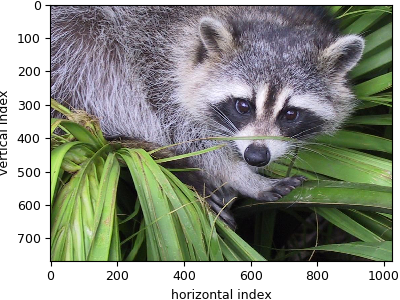Pixel, 2D{3} datasets¶
The 2D{3} datasets is two dimensional, \(d=2\), with a single three-component dependent variable, \(p=3\).
Image datasets¶
A common example from this subset is perhaps the RGB image dataset. An RGB image dataset has two spatial dimensions and one dependent variable with three components corresponding to the red, green, and blue color intensities.
The following is an example of the RGB image dataset.
>>> import csdmpy as cp
>>> filename = 'Test Files/image/raccoon_image.csdf'
>>> ImageData = cp.load(filename)
>>> print (ImageData.data_structure)
{
"csdm": {
"version": "1.0",
"read_only": true,
"timestamp": "2016-03-12T16:41:00Z",
"tags": [
"racoon",
"image",
"Judy Weggelaar"
],
"description": "An RBG image of a raccoon face.",
"dimensions": [
{
"type": "linear",
"count": 1024,
"increment": "1.0",
"label": "horizontal index"
},
{
"type": "linear",
"count": 768,
"increment": "1.0",
"label": "vertical index"
}
],
"dependent_variables": [
{
"type": "internal",
"name": "raccoon",
"numeric_type": "uint8",
"quantity_type": "pixel_3",
"component_labels": [
"red",
"green",
"blue"
],
"components": [
[
"121, 138, ..., 119, 118"
],
[
"112, 129, ..., 155, 154"
],
[
"131, 148, ..., 93, 92"
]
]
}
]
}
}
The tuples of the dimension and dependent variable instances from
ImageData instance are
>>> x = ImageData.dimensions
>>> y = ImageData.dependent_variables
respectively. There are two dimensions, and the coordinates along each dimension are
>>> print('x0 =', x[0].coordinates[:10])
x0 = [0. 1. 2. 3. 4. 5. 6. 7. 8. 9.]
>>> print('x1 =', x[1].coordinates[:10])
x1 = [0. 1. 2. 3. 4. 5. 6. 7. 8. 9.]
respectively. In the above example, only the first ten coordinates along each dimension are displayed.
The dependent variable is the image data, as also seen from the
quantity_type attribute
of the corresponding DependentVariable instance.
>>> print(y[0].quantity_type)
pixel_3
From the value pixel_3, pixel indicates a pixel data point, while 3 indicates the number of pixel components.
As usual, the components of the dependent variable are accessed through
the components attribute.
To access the individual components, use the appropriate array indexing.
For example,
>>> print (y[0].components[0])
[[121 138 153 ... 119 131 139]
[ 89 110 130 ... 118 134 146]
[ 73 94 115 ... 117 133 144]
...
[ 87 94 107 ... 120 119 119]
[ 85 95 112 ... 121 120 120]
[ 85 97 111 ... 120 119 118]]
will return an array with the first component of all data values. In this case,
the components correspond to the red color intensity, also indicated by the
corresponding component label. The label corresponding to
this component array is accessed through the
component_labels
attribute with appropriate indexing, that is
>>> print (y[0].component_labels[0])
red
To avoid displaying larger output, as an example, we print the shape of each component array (using Numpy array’s shape attribute) for the three components along with their respective labels.
>>> print (y[0].component_labels[0], y[0].components[0].shape)
red (768, 1024)
>>> print (y[0].component_labels[1], y[0].components[1].shape)
green (768, 1024)
>>> print (y[0].component_labels[2], y[0].components[2].shape)
blue (768, 1024)
The shape (768, 1024) corresponds to the number of points from the each dimension instances.
Note
In this example, since there is only one dependent variable, the index
of y is set to zero, which is y[0]. The indices for the
components and the
component_labels,
on the other hand, spans through the number of components.
Now, to visualize the dataset as an RGB image, we use the matplotlib imshow method.
Tip
RGB image plot
>>> import matplotlib.pyplot as plt
>>> import numpy as np
>>> def image_data():
... fig, ax = plt.subplots(1,1, figsize=(4,3))
... ax.imshow(np.moveaxis(y[0].components, 0, -1 ))
... ax.set_xlabel(x[0].axis_label)
... ax.set_ylabel(x[1].axis_label)
... plt.tight_layout(pad=0, w_pad=0, h_pad=0)
... plt.show()
>>> image_data()

